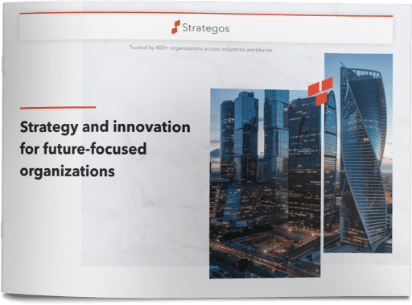Innovation assessments help executives make informed decisions about investing in innovation. Every year businesses are allocating more resources to innovation capabilities in pursuit of growth as studies demonstrate the direct link between innovation and financial performance. Some of this confidence seems misplaced as many executives are disappointed with the return on their innovation investments. It is clear to most that just spending more doesn’t automatically lead to success. Top performers in innovation make their investment choices wisely and base it on understanding the gap between their current capabilities and what is needed to deliver outstanding, world-class performance.
Four steps towards a world-class innovation capability
Every organisation innovates, and you’re never starting from a greenfield situation. Whether you’re a CxO responsible for innovation or the executive that leads the initiative, there are two things you want to do before you can make decisions:
Step 1: Perform an Innovation Assessment to identify your current capabilities
Step 2: Define the company’s aspiration and scope for innovation
Performing an assessment will be beneficial to get you started in the right way and provide the insights you need to then decide where and how to prioritise your investments in steps 3 and 4.
Step 3: Identify gaps and plan to address them
Step 4: Continue to monitor progress during implementation
We’ll focus on steps one and four since we have covered two and three in previous posts and webinars.
How to perform innovation assessments
We have been evaluating client innovation capabilities and developing innovation strategies since 1995. The Strategos Innovation System defines requirements that make a clear distinction between Baseline and world-class innovation capabilities. Strategos tested and refined these requirements through dozens of engagements with high growth companies across several industries. We have developed a proprietary toolbox to assess a company’s innovation capability through, e.g. surveys, interviews, workshops and case-based research.
Ask the right questions
Innovation assessments should separate popular opinion from fact. The quality of the result depends on the topics covered, how you formulate the questions, and what answers respondents can select. Most will only ask for people’s opinions on a rating scale. While these ratings create beautiful charts and diagrams for your presentation, the results should be interpreted with caution since they could even be misleading. The following examples illustrate this point.
Example question 1:
Is our organisation is willing to take risks?
- Often
- Sometimes
- Hardly ever
- Not at all
Example question 2:
Do we have a strategy for innovation?
- It is documented and actively communicated
- It is documented and accessible for anyone
- Only senior executives have access
- We do not have one
The first question leads to opinion; everyone will interpret risk in different ways, whereas the second one can be verified.
Insights question #1: If it is true that the organisation is risk averse the focus needs to be on behavioral change. If it isn’t true the issue may be a lack of communication or clarity about what the business is expecting from innovation. While it may not even be true that the organisation is risk averse, the opinion (or belief it is so) may still lead to filtering ideas that could lead to disruption.
Insight question #2: Since we can verify this, any result that isn’t a confirmation could point to a communication problem. The verified result positions the company on our innovation index and could result in a gap we need to address.
Opinions are essential indicators to consider and shouldn’t be confused for facts that could potentially lead to taking the wrong actions.
Focus on qualitative AND quantitative
Performance data helps us to verify some of the answers that people give and also provide further visibility into input, throughput and the output as a result of your investments in innovation to date. This picture may be incomplete because as many as 25% of companies do not track the impact of innovation directly. Metrics (see link to article at the end of the article) are essential and necessary to monitor progress and measure impact.
Look for barriers and enablers
Often, the most critical obstacles for innovation are not processes or resource constraints, but embedded beliefs about how the business should operate. These beliefs can prevent people from being productive and in the worst cases, cause innovations to halt altogether. Examining past innovation cases help us identify these barriers that we’ll need to address as well as surface strong enablers that we can leverage.
Visualise internal innovation communities
When you’re a startup, you know everybody that’s working in the company. But the largest of businesses often have pockets of innovation in different parts of the organisation with varying levels of sophistication and visibility. We understand that these informal networks or communities of practice are vital to solving problems and developing new ideas. Worlds class innovators identify and leverage these pockets of capability and provide support to strengthen and scale their impact on performance. Our innovation assessment visualises those internal networks and finds ways to strengthen them.
Monitoring and measuring progress
At the start of 2020, we’ve announced our partnership with Temporall to develop real-time organisational intelligence with a focus on innovation capabilities. Our collaboration will enable clients to surface insights about their innovation capability as well as monitor their progress to improve innovation capability over time. The workbench that Temporall provides us incorporates machine learning, tagging, and organisational network analysis. This digital platform will provide our clients with a quicker assessment turnaround as well as autonomy after we complete the initial assessment.
We’re very excited to continue to improve how we help our clients professionalise innovation and achieve the levels of impact and performance gains of world-class innovators.
Get in touch to learn how this can work for your organisation?
The workbench that Temporall provides us incorporates machine learning, tagging, and organisational network analysis. Combined with Strategos’ frameworks this digital platform will provide our clients with a quicker assessment turnaround as well as autonomy after we complete the initial assessment.
Further reading:





